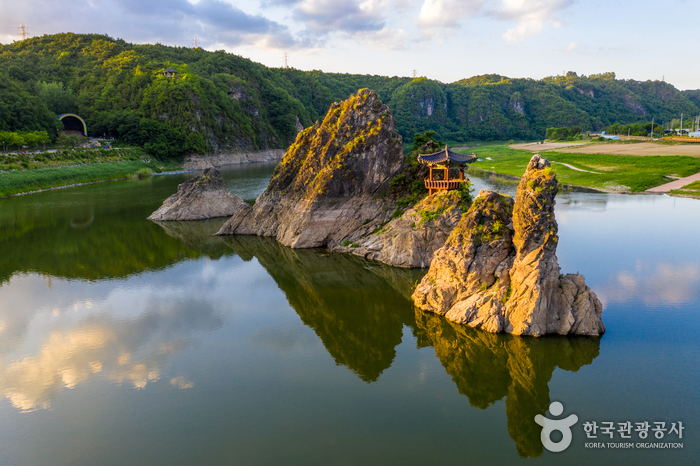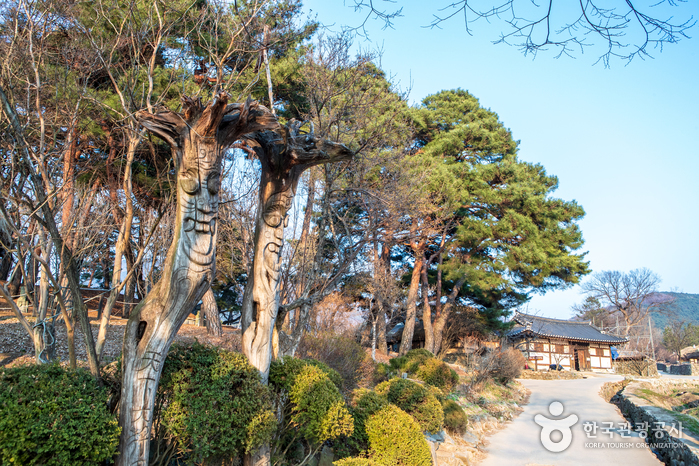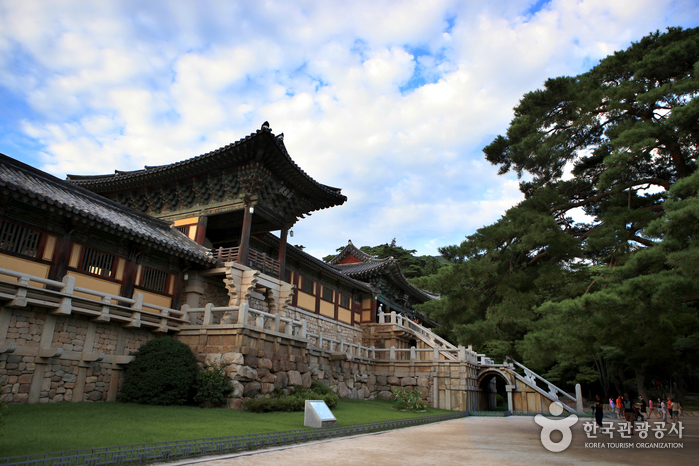Gongju Gongsanseong Fortress [UNESCO World Heritage] (공주 공산성 [유네스코 세계문화유산])
2024-03-15
280 Ungjin-ro, Gongju-si, Chungcheongnam-do
+82-41-856-7700
Gongsanseong Fortress is a fortification situated at the heart of Gongju, which served as the capital of the ancient Baekje kingdom (18 BCE - 660 CE) from 475 to 538. Even after Baekje's fall, subsequent dynasties such as Silla (57 BCE - 935 CE), Goryeo (918-1392), and Joseon (1392-1897) continued to use Gongju as a regional administrative center. As a result, numerous historical sites have accumulated in the area over time. From the fortress, visitors can enjoy a panoramic view of Gongju’s city center and the Geumgang River.
Eight Scenic Views of Danyang (단양 팔경)
2020-08-19
Danseong-myeon, Danyang-gun, Chungcheongbuk-do
+82-43-422-1146
The Eight Scenic Views of Danyang are known as the most beautiful places in Danyang, and include Dodamsambong Peaks and Seongmun Natural Arch by the Namhangang River, Gudambong Peak and Oksunbong Peak offering outstanding views of Chungjuho Lake, Sangseonam Rock, Jungseonam Rock, and Haseonam Rock in Seonamgyegok Valley, and Sainam Rock in Unseongugok Valley. Theses areas were visited many times by numerous scholars during the Joseon dynasty and contain many historically and culturally important relics.
Boeun Beopjusa Temple [UNESCO World Heritage] (보은 법주사 [유네스코 세계문화유산])
2021-10-23
405, Beopjusa-ro, Boeun-gun, Chungcheongbuk-do
+82-43-543-3615
Built in 553 during the 14th year of Silla King Jinheung's reign, Beopjusa Temple is located on Songnisan Mountain. However, many of the original buildings were destroyed during the Imjin War (1592-1598), with the current structures having been rebuilt in 1624. The temple features many beautiful and important Buddhist relics and artworks, centered around the main hall, Daeungbojeon Hall.
Onyang Hot Springs (온양온천지구)
2024-03-28
1459 Oncheon-daero, Asan-si, Chungcheongnam-do
+82-41-540-1234
Onyang Hot Springs is the oldest hot springs complex in Korea, a place where the kings of Joseon (1392-1897) recuperated and bathed, thanks to its proximity to Seoul. In the 1970s and 1980s, it was a popular honeymoon destination. The water here has a temperature of about 44-60℃ and contains substances that are beneficial for the human body. The area boasts a large number of hotels and water parks.
Oeam Folk Village (외암민속마을)
2025-10-23
13-2 Oeamminsok-gil 9beon-gil, Songak-myeon, Asan-si, Chungcheongnam-do
+82-41-540-2110
Oeam Folk Village, located in Asan, boasts a history spanning over 500 years. This agricultural village has preserved its ancient houses and cultural heritage remarkably well. At the entrance, visitors are greeted by a recreation of a traditional market. The village offers Hanokstay programs, allowing guests to stay in traditional Korean houses, and provides interactive experiences that recreate traditional Korean agricultural practices and crafts.
Chungjuho Lake (충주호)
2024-03-08
Jodong-ri, Dongnyang-myeon, Chungju-si, Chungcheongbuk-do
+82-43-850-5114
Chungjuho Lake is the nation’s largest lake, and was formed after the construction of Chungju Dam. When constructing the dam, an area of approximately 66.48 ㎢ was submerged throughout three regions in Chungju, Danyang and Jecheon. Even though nearly 50,000 people lost their hometown, the lake became a famous regional tourist spot, along with Woraksan National Park, Songgye Valley, Cheongpung Culture Center, Eight Sceneries of Danyang, Gosu Cave, Guinsa Temple, Suanbo Hot Springs, Nodong Cave and other spots.
Tourists can enjoy the scenic area on five ferry docks from Chungjunaru, main ferry dock of Chungju Dam, Cheongpungnaru, Janghoenaru where Gudambong Peak and Oksunbong Peak are located, Danyangnaru in Danyang-eup, and Woraknaru located near the beautiful scenery of Woraksan Mountain. From Chungju Dam to Janghoenaru, it takes approximately 1 hour 30 minutes, making it a long-distance course and offers special sightseeing on board. This course also holds great views of Chungjuho Lake and Yeongbong Peak of Woraksan Mountain, the surrounding scenery of Woraknaru, and two scenic spots of Danyang which are Gudanbong and Oksunbong Peak featuring uniquely-shaped rocks and peaks. This course is the most attractive among Chungjuho ferry excursion routes.
Gyeongju National Park (경주국립공원)
2024-02-27
12 Cheonbungnam-ro, Gyeongju-si, Gyeongsangbuk-do
+82-54-778-4100
Gyeongju National Park, designated as a national park in 1968, holds a special status as Korea's only historical national park. The park spans 136.55㎢ across eight districts, including Tohamsan Mountain, home to the exquisite Buddhist treasures of Bulguksa Temple and Seokguram Grotto, as well as Namsan Mountain, known as the "Buddhist Museum," showcasing the pinnacle of Buddhist culture. The park boasts significant relics from the Silla dynasty alongside breathtaking natural landscapes. Recognized by UNESCO in 1979 as one of the top ten historic sites globally, it stands as a world-renowned cultural heritage site.
Magoksa Temple [UNESCO World Heritage] (마곡사 [유네스코 세계문화유산])
2025-06-10
966 Magoksa-ro, Sagok-myeon, Gongju-si, Chungcheongnam-do
+82-41-841-6220
Situated at the foot of Taehwasan Mountain in Gongju, Magoksa Temple was established in 640. It is reputed to protect its occupants from war, and indeed, the temple survived the Japanese invasion of Korea (also known as the Imjin War; 1592-1598) and the Korean War (1950-1953). It houses numerous cultural heritage items, and visitors can participate in the Templestay program to experience life in a Korean Buddhist temple.
Woraksan National Park (월악산국립공원)
2023-03-24
1647, Mireuksonggye-ro, Jecheon-si, Chungcheongbuk-do
+82-43-653-3250
Woraksan National Park is located along the Baekdudaegan Mountain Range between Sobaeksan and Songnisan Mountains. The rugged mountain is softened by the waterfalls and small pools found within the valleys. The area was designated as a national park on December 31, 1984. The mountain is surrounded by Chungjuho Lake to the north, the Eight Scenic Views of Danyang and Sobaeksan Mountain to the east, and Mungyeongsaejae Pass and Songnisan Mountain to the south. The main peak of Woraksan National Park is Yeongbong Peak, reaching an altitude of 1,097 meters above sea level. The path there is steep, with sections of rock stretching 150 meters in x_height. There is also a 4-kilometer-long path circling the base rock.
May 18th National Cemetery (국립 5·18 민주묘지)
2024-07-11
200 Minju-ro, Buk-gu, Gwangju
+82-62-268-0518
The May 18th National Cemetery in Gwangju is a symbol of freedom and democracy. The cemetery holds the graves of 764 victims of the May 18th Democratic Uprising in 1980, seven structures, and many monuments.
![Gongju Gongsanseong Fortress [UNESCO World Heritage] (공주 공산성 [유네스코 세계문화유산])](http://tong.visitkorea.or.kr/cms/resource/75/2678675_image2_1.jpg)

![Boeun Beopjusa Temple [UNESCO World Heritage] (보은 법주사 [유네스코 세계문화유산])](http://tong.visitkorea.or.kr/cms/resource/58/1731558_image2_1.jpg)




 English
English
 한국어
한국어 日本語
日本語 中文(简体)
中文(简体) Deutsch
Deutsch Français
Français Español
Español Русский
Русский